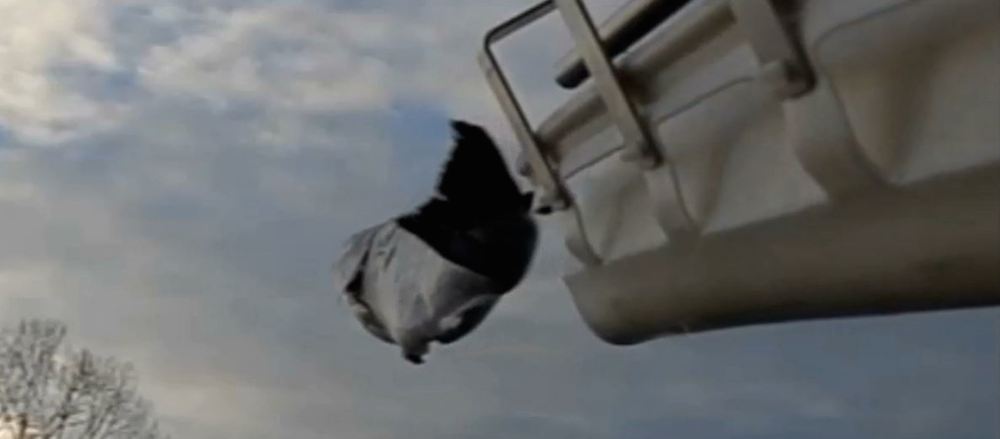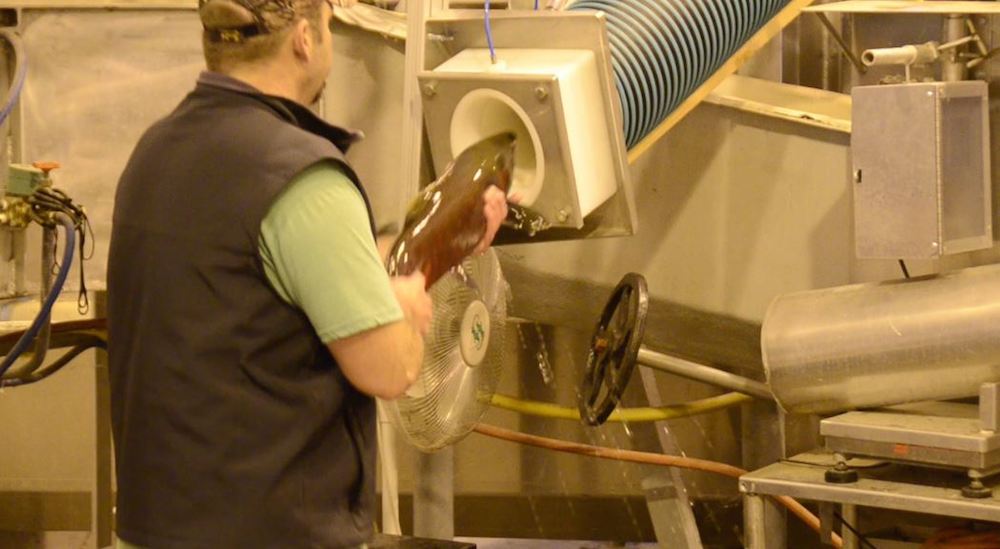Whoosh: ‘Salmon Cannon’ Shoots Fish Upstream to Spawn

The long tube wiggled and then violently wobbled, shaking as a salmon came blasting out the end and belly-flopped into the water.
Still in its pilot phase, the cannon-type device, "o'fish'ally" known as the Whooshh Transport Conduit, can zip fish between 16 and 33 feet per second (5 and 10 meters per second) above obstacles, such as dams, and toward their destination.
The device is designed to help salmon reach their spawning grounds, but late-night talk-show host and comedian John Oliver launched the so-called salmon cannon into the spotlight by giving his audience a preview of how it works, and pretending to use it to launch fake salmon at A-list celebrities, including Jon Stewart, Jimmy Fallon and Anderson Cooper. [Video: 'Salmon Cannon' To Migrate Fish Upstream]
But all jokes aside, the salmon cannon could play an important role in helping fish journey upstream. The tube's speed and flexibility may provide a more affordable and sustainable solution than other manmade waterways around dams that are currently used by migrating fish, said Vince Bryan III, CEO of Whooshh Innovations, based in Bellevue, Washington, and the creator of the salmon cannon.
The great migration
Typically, dams have manmade fish ladders to help fish swim upstream. Water flows over a series of steps, and the determined fish leap up repeatedly, climbing up the steps until they exit into the river at the top of the dam.
But sometimes fish will turn around if the water in a fish ladder is too warm. Other times, the ladder may disorient fish, causing them to turn around and go up and down the steps repeatedly, instead of straight toward the exit, said Dave Fast, a senior research manager at Yakima Nation Fisheries, which is conducting a pilot project on the cannon.
Sign up for the Live Science daily newsletter now
Get the world’s most fascinating discoveries delivered straight to your inbox.
"This [conduit] is a much more rapid way to get [salmon] upstream," Fast said.
But how long can a fish survive out of water? Long enough, it seems, for a 120-foot (37 meters) tube to vacuum up the fish and shoot it upriver, closer to the salmon's spawning grounds, research shows.
"In a lot of the fish-handling facilities and hatcheries, fish are out of the water for a minute or two," Bryan told Live Science. "We were surprised how long that was. We just had in mind a few seconds."
Though the name "cannon" is catchy, the device doesn't actually operate like one. Instead, it acts a little like a vacuum cleaner. As a fish enters the tube, it is sprayed with a mist that keeps its gills moist and the inside of the tube wet. The fish immediately whizzes up the tube because the pressure in front of it is lower than the pressure behind it.
This differential pressure creates a seal around the fish's middle, holding it steady as the fish speeds along. As the seal lets go of the fish toward the tube's end, the fish slows down — friction, gravity and increased water help it decelerate too — as it is released into the water, far from the hungry eyes of predators. [Photos: The Freakiest-Looking Fish]
"When you look at most fish, they're doing a belly-flop when they land," Bryan said. "We're trying to replicate that as if they were jumping out of the water in the wild."
How 'bout them apples?
The concept for the fish cannon began in a fruit field. Bryan's family owns an apple orchard in eastern Washington, but his father noticed that the workers spent only about half of their time picking apples. The other half of the time was spent carrying the picked apples to a collection point in the middle of the road.
"We set up to solve the problem, how do you get a piece of fruit from the tree into the bin softly?" Bryan said. "If you bruise the fruit, it's lost its value."
They developed a harvester that allowed pickers to stay in their ladders and drop the apples into tubes that gently transported the fruit to the bins.

Eventually, Bryan's family set out to repurpose the technology for other products. "The lowest hanging fruit seem[ed] to be in the arena of fish, whether it be in the processing plants or in the wild," Bryan said.
Still, fish are slippery, heavy and difficult to move. It's unclear whether the tube will stress out the fish, or even if the cannon will remove the slimy coating that protects the fish from parasites and pathogens, though tests have shown that the tube leaves the slime intact, Bryan said.
The tube doesn't appear to increase short-term stress on rainbow trout, according to a 2013 U.S. Geological Survey study, published in the North American Journal of Fisheries Management, that examined the fishes' cortisol levels. Now, Yakima Nation Fisheries is studying the salmon cannon's effects on long-term stress, Fast said.
Spring swim
In the spring, salmon swim around the Roza Dam on the Yakima River on their journey back to their spawning grounds. Some of the salmon are taken to the Cle Elum Hatchery in a special truck, where workers spawn the fish for the next season.
About 120 Chinook, also known as king salmon, traveled through a 40-foot (12 m) cannon during their migration in the spring. Experts are studying whether the fish that were shot through the tube have a higher death rate than fish transported by hand into the truck, Fast said.
"They shoot through this tube rather painlessly for 5 seconds," he said. "We don't expect any long-term impact, but we're checking."
The study is ongoing, but so far the researchers have not found any statistical difference in the mortality of the fish, Bryan said. [Photos of the Largest Fish on Earth]
Improving the technology
The company is also working on a tube that will accommodate all sizes of fish, from young jacks to mature adults. Whooshh currently has two cannon sizes, one that accommodates fish between 8 and 12 pounds (3.6 and 5.4 kilograms) and another one for fish larger than 12 pounds.
"It can handle over a range of sizes, but it can't handle all of the sizes of a salmon coming back," Fast said. "We're working on it so we don't have some great big fish come along and stick his head in and plug the whole thing up."
The portable 120-foot (37 m) tube costs roughly $148,000, about half as much as a pesculator, a large corkscrew-type device that brings fish to the surface, said Eric Kinne, a hatchery reform coordinator at the Washington Department of Fish & Wildlife. Pesculators can reach up to 30 feet (9.1 meters) tall, but are typically used at hatcheries, not dams, Bryan said.
The department used the 120-foot tube to transport fish from the Washougal River in southern Washington to a truck that took them to the Washougal hatchery, about 14 miles (23 kilometers) away, Kinne said.
Elsewhere, the salmon cannon is also catching on. A fish-processing plant in Norway is using a 500-foot (152 m) tube for commercial purposes for fish that are already dead, and the Pacific Northwest National Laboratory, one of the U.S. Department of Energy's national labs, just tested a 40-foot and 250-foot (12 m and 76 m) section of the tube in October, comparing it to the traditional "trap and haul" process that trucks fish upriver.
In 2015, Whooshh expects to have its first full-time operational cannon at a river in Washington, Bryan said. The cannon will likely speed up the fish's journey and save them energy, he said. "That should translate to a higher return rate of the fish at the spawning grounds."
Follow Laura Geggel on Twitter @LauraGeggel. Follow Live Science @livescience, Facebook & Google+. Original article on Live Science.

Laura is the archaeology and Life's Little Mysteries editor at Live Science. She also reports on general science, including paleontology. Her work has appeared in The New York Times, Scholastic, Popular Science and Spectrum, a site on autism research. She has won multiple awards from the Society of Professional Journalists and the Washington Newspaper Publishers Association for her reporting at a weekly newspaper near Seattle. Laura holds a bachelor's degree in English literature and psychology from Washington University in St. Louis and a master's degree in science writing from NYU.









